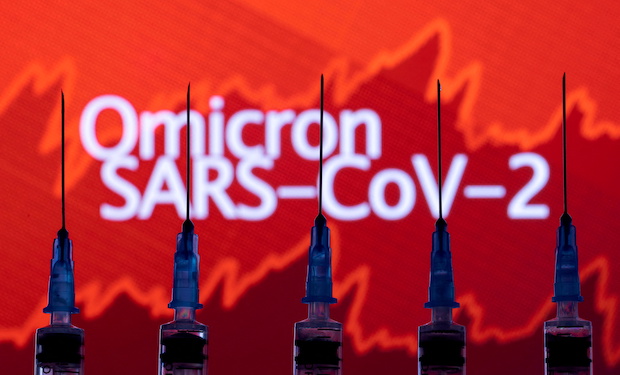Omicron community transmission in Metro Manila confirmed – DOH

(REUTERS/Dado Ruvic/Illustration)
MANILA, Philippines — Metro Manila is experiencing community transmission of the Omicron variant of the new coronavirus, the Department of Health (DOH) confirmed on Saturday, as the country hit another record high of new COVID-19 cases with 39,004, the fourth time this week that more than 30,000 infections were tallied.
“In the National Capital Region (NCR), we are seeing community transmission of the Omicron variant. Even though our whole genome sequencing cannot catch up, we already have determined that there are local cases already,” Health Undersecretary Maria Rosario Vergeire said at Saturday’s Laging Handa briefing.
Her remarks confirm the same assertion which Dr. Rontgene Solante, chief of the Adult Infectious Diseases and Tropical Medical Unit at San Lazaro Hospital, made also at the same briefing on Jan. 8, two Saturdays ago.
He said at that time that “there is already community transmission of [the] Omicron variant,” whereas the DOH asserted then that Omicron was a “variant of concern” while Delta remained “the most transmissive” variant.
Other regions
The capital region has been contributing the highest number of COVID-19 cases nationwide, but Vergeire said other regions are seeing an increase in their numbers as well.
Article continues after this advertisementShe said that besides Metro Manila, Cagayan Valley, Cordillera Administrative Region, Central Luzon and Calabarzon (Cavite, Laguna, Batangas, Rizal and Quezon) have “critical case risk classification.”
Article continues after this advertisementBut she also said all regions are now classified as high risk.
“In these regions, we see the same characteristics that are happening in the NCR,” Vergeire said, as she cited such factors as high transmissibility and a sharp rise in the number of cases.
“So when we look at this, it seems there will come a time when the Omicron variant will be the dominant variant in the country, if this kind of transmission will continue,” she said.
Cases may double
According to Vergeire, NCR has had a daily average of 17,124 cases, compared with 6,500 a week ago.
At that time, new cases began to breach the 20,000 mark with 21,819 on Jan. 7, a steep rise from just 4,600 on Jan. 3, the start of that week.
She said current active cases in the metropolis are at 149,000—a figure that she said may even double by February.
“We [have] still yet to see the peak, which may happen at the end of the month or even later, about second week of February, and we see that the number of active cases may double compared to today by that time of Feb. 15,” Vergeire said.
But she also noted that the case doubling time in Metro Manila, as well as in the country, has gone down to four days from 2.2 days, even as she emphasized that cases were still rising.
She said: “We see the slowdown [in the growth of cases], but we need to understand that the number of cases still continue[s] to increase. It’s not just the slowing down of cases we look at, but the increase in the number of cases. We need to keep a close watch on this.”
Metropolitan Manila Development Authority Chair Benjamin Abalos said there was no need to impose a curfew in Metro Manila since residents have mostly been staying at home and “have learned … to self-regulate.”
“On their own, the people are not going out because they know there is high transmissibility,” he said.
Virus case update
The 39,004 active cases reported on Saturday were a further increase from the 37,207 on Friday and 34,021 on Thursday.
But of the total active cases now at 280,813, the majority were mild infections at 267,185. Asymptomatic cases were at 8,928; moderate, 2,925; severe, 1,472; and critical, 303. Total COVID-19 cases since the pandemic began were at 3,168,379, of which there were 2,834,708 survivors with the addition of 23,613 recoveries.
Saturday’s bulletin added 43 fatalities to the death toll now at 52,858.
The positivity rate was at 47.1 percent—more than nine times the 5-percent threshold set by the World Health Organization—based on 78,774 tests conducted on Thursday.
Despite these considerable numbers, the OCTA Research Group said the daily growth rate of infections in Metro Manila was “steadily declining.”
“It has now decreased to 3 percent from 5 percent a day before,” OCTA fellow Dr. Guido David said in a tweet on Saturday.
“Once the daily growth rate becomes negative, new cases in the NCR [will start] decreasing,” he added.He said the reproduction number in the metropolis dropped to 3.22 on Tuesday from 3.77 the previous day.
Guido projected that Metro Manila would experience a “consistent decrease” in coronavirus infections in the coming days.